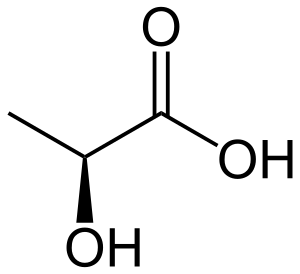Lactic acid fermentation facts for kids
Lactic acid fermentation is a natural process where glucose (a type of sugar) and other sugars are changed into lactic acid. This process also creates energy. Sometimes, other things are made too. Lactic acid bacteria use this process to get energy. Even fungi, plants, and animals can use it when they don't have enough oxygen. For example, it happens in your muscle cells when you exercise hard and your body needs more oxygen than it can get. In humans, this happens if there's too little oxygen in the blood, which is called Hypoxemia.
There are a few ways lactic acid fermentation can happen:
- Homolactic fermentation: This is when lactic acid is the main thing produced.
- Heterolactic fermentation: This makes other things besides lactic acid. For example, it can make ethanol (alcohol) and carbon dioxide from some sugars, or acetic acid from others.
- Certain bacteria, like Bifidobacterium, make both lactic acid and acetic acid.
Contents
How Lactic Acid Fermentation Helps Preserve Food

Lactic acid fermentation is a cool way to make food last longer. People have been using it for thousands of years, even since the Stone Age! This process helps by stopping bad bacteria from growing and spoiling food. It can even kill some of them.
You probably know some foods made this way, like yogurt (which is fermented milk), sauerkraut (fermented cabbage), and kimchi.
The Story of Lactic Acid Fermentation
Scientists in the 1800s learned a lot about how chemicals work. Joseph Louis Gay-Lussac and his student Justus Liebig were chemists who studied fermentation. They figured out what the lactic acid molecule looked like. They were mostly interested in the chemical side of things.
Then, in 1857, a French chemist named Louis Pasteur made a big discovery. He was the first to show that tiny living things, called microorganisms, were actually responsible for making lactic acid during fermentation. He was working at a university and helped a local brewery with their fermentation problems. He found that two different fermentations were happening: one made lactic acid, and the other made alcohol. Both were caused by microorganisms.
Pasteur's ideas were different from what other chemists thought. He showed that fermentation was a "form of life without air." Even though he didn't find every tiny detail, he discovered the main way microbial lactic acid fermentation works.
People were using microbial fermentation to make food long before Pasteur explained it. Archeologists have found proof that fermenting milk has a very long history. It might have started around the time of the Neolithic revolution, when people began farming. Milk naturally contains lactic acid bacteria. If the temperature is right, fermentation happens on its own.
Early farmers had a challenge: many adults couldn't digest fresh milk. Lactic acid bacteria have special helpers called enzymes that break down lactose, the sugar in milk. When milk ferments, these bacteria grow a lot. So, even a short fermentation makes the milk easier for adults to digest. Longer fermentation, like for making cheese, was even safer and was also discovered a very long time ago. We know this from ancient writings like Cuneiform scripts and texts from Babylonian and Egyptian times.
How Fermentation Shaped Cultures
Fermented milk products have been very important in some cultures. For example, in Mongolia, people often raise animals for milk, especially mare (horse) milk. They have a long tradition of drinking fermented mare milk, called kumis, which is a slightly alcoholic yogurt.
Kumis is especially important during cultural celebrations like the Mongolian lunar new year. This time is called the "white month" because milk products (called "white food") are central to the traditions. Eating white food during these celebrations connects people to their past and their national identity, especially to the great Mongol Empire and Genghis Khan. In the past, fermented mare milk was a special drink for warriors and leaders. Even though it's now a drink for everyone, it still has a special meaning.
Today, this tradition is changing because of globalization. Other products, like industrial yogurt from other countries, are becoming more common, especially in cities. But in rural areas, traditional fermented mare milk is still very important.
Where Lactic Acid Fermentation is Used Today
Lactic acid fermentation is used all over the world to make foods that can't be made any other way. The most important type of bacteria for this is Lactobacillus, but other bacteria and even yeast are sometimes used. Two common examples are yogurt and sauerkraut.
Making Sauerkraut
Lactic acid fermentation is key to making sauerkraut. The main type of bacteria used for sauerkraut is Leuconostoc.
Just like in yogurt, when the sauerkraut gets more acidic from the lactic acid, many harmful germs are killed. The bacteria make lactic acid, and also simple alcohols and other chemicals. These can mix together to create the special flavor of sauerkraut.
Making Yogurt
The main way to make yogurt is by fermenting milk with harmless bacteria. The most common bacteria used are Lactobacillus bulgaricus and Streptococcus thermophilus. In many places, like the United States and Europe, laws say that all yogurts must have these two types of bacteria.
These bacteria make lactic acid in the milk. This makes the milk more acidic and causes it to thicken into yogurt. The bacteria also make things that give yogurt its unique taste. The acidic environment also stops many harmful bacteria from growing.
Sometimes, other types of bacteria, like Lactobacillus acidophilus, are added to make "probiotic" yogurt, which can be good for your gut health.
Images for kids
-
This animation shows how one molecule of glucose turns into lactic acid.
See also
 In Spanish: Fermentación láctica para niños
In Spanish: Fermentación láctica para niños



